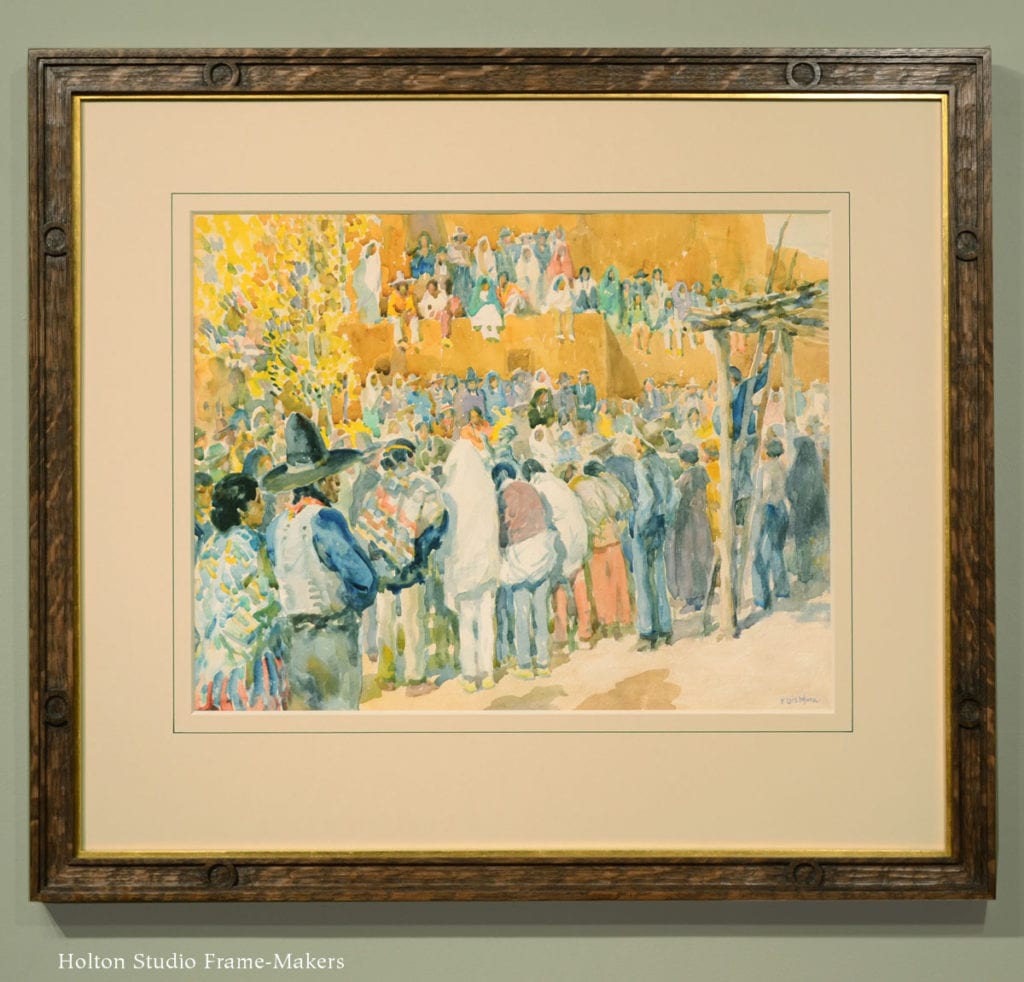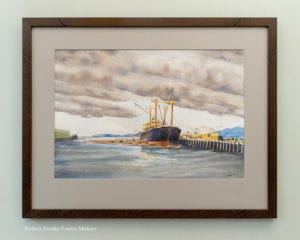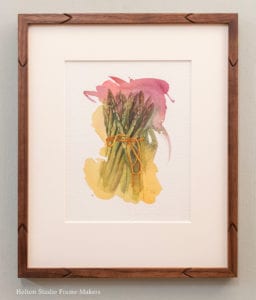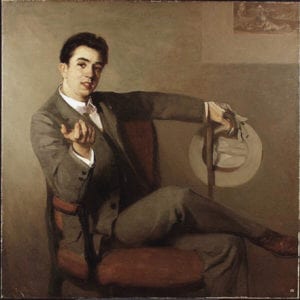In preparation for my talk tomorrow, “A Frame-Maker’s Approach to Framing Watercolors,” I’m posting this delightfully festive, early twentieth century impressionist watercolor, “Santa Fe Race Scene.” The artist is the noted Hispanic-American painter, illustrator, muralist, and teacher Francis Luis Mora (1874-1940). We framed this one a number of years ago, but it’s such an appealing piece and I’ve always been pleased with the framing.
The Frame
The frame, which is 1-1/4″ wide, is made in quartersawn white oak with a Weathered Oak stain, and has a gilt slip repeating the yellows of the sun-drenched day. For such a loose, impressionistic painting which is less concerned with line or depicting three-dimensional form than it is in the dance of color and pattern, I used a less formal or refined profile. (Mora’s self-portrait at the bottom of this post, for example, would call for a more formal frame profile, such as a cove or ogee, to suit the subtle rendering of the figure.) The texture of the carved surfaces of the molding echo the painting technique. The carved circles near the corners give emphasis to the frame’s joints and provide a suitably simple decorative motif to celebrate the picture and echo all the circles used to render the heads and faces in the crowd, many framed by serapes. For a picture capturing the life of a culture that hasn’t lost the instinct to decorate its arts, decoration in the frame feels necessary. In fact, the absence of decoration might have actually felt incongruous.
Matting and Framing Close
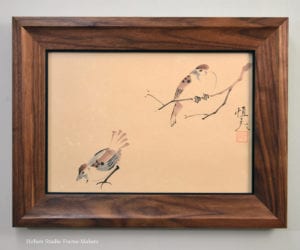
A Japanese watercolor framed close, subject of yesterday’s post.
One thing I’ll discuss in tomorrow’s presentation is the choice between matting watercolors and framing them “close”—i.e., without a visible mat. Yesterday’s post, in contrast to today’s, showed a watercolor framed close in a relatively wide frame (right). In framing pictures in general, the rule of thumb is to either use no mat and a wide frame or a mat with a narrow frame. A wide frame outside a wide mat is too dominant and pulls the eye away from the picture, whereas a narrow frame remains visually subordinate. In any case, the pleasing and compelling window effect of a wide frame used close is largely lost once there’s a mat. When matted, the picture’s role in the decor of a room becomes less architectural and more decorative, if you will. But in any case, the goal, as always, is to connect, not separate, the picture from its larger setting.
Watercolors present an excellent opportunity to discuss this fundamental problem in framing because, whereas other media—including traditional Japanese block prints, the topic of a parallel talk I gave in March—can, as a rule, be said to call for one or the other approach, in the case of watercolors it depends entirely on the particular picture. The Japanese painting of two birds, yesterday’s example, was very simple and had a great deal of space around the subjects, whereas the Mora, above, is very busy, and the painting fills the picture area. The image’s density and busy-ness benefits from the complementary blank space the mat provides. Also, the medium of watercolor is significantly more delicate than oil paint, and is easily overwhelmed by a wide frame. In addition, we’re almost always seeing the paper through the paint, and paper is a more delicate support than canvas or wood; and is, in any case, basically the same material as mat board and therefore naturally harmonizes with a mat. On a busy picture like the Mora, a problem with a plain mat can be that, while it provides needed quiet surrounding space, the eye seems to want a harder line to “contain” the action. But this can be provided, as we did on the Mora, by an ink line just outside the mat window. (An ink line is also consistent and harmonious with the medium of the picture.) A painted bevel or the deeper bevel of an 8- or 12-ply mat can also provide this line. Otherwise, the mat should be plain so that it provides a “space of silence” which many pictures need to allow the eye to dwell on them.
If the decision is made to mat the picture, the choice of mat color becomes a crucial question. The mat strongly effects the viewer’s perception of color and value in the picture, as well as the eye’s natural attraction to the picture. The eye goes to light, color intensity, and contrast. There is a distinct sensation of relaxation in the eyes when the right mat is found, because the mat is neutral in relation to the colors and values in the picture. Most people grasp the idea of a mat being neutral, but don’t understand that that means careful selection based on and within the terms of the color scheme of the picture. The most common example of this mistake is believing that the most neutral color for a mat is white, when in fact white is at the extreme end of the value spectrum. Therefore, in most cases (but not always), a white mat pulls the eye from the picture as well as throws off the value balance the artist created. It also, by complement, over-emphasizes the picture’s dark tones. In respect to value and color, the mat should occupy the middle, the balancing point, you might say, of the picture’s color and value scheme.
The common exception is that of watercolors on white paper that leave much of the paper exposed. In those cases, like the Tia Kratter painting at right, the white mat is the best choice, and simply extends and enlarges the piece.
But more discussion of all that in the presentation.
Saturday’s talk is at 3:00, followed by an opening reception from 4:00 to 6:00 for our exhibit Robert Tetlow (1922-1988): A Berkeley Watercolorist Rediscovered and Remembered. I hope you’ll come!
Learn more about F. Luis Mora
According to Wikipedia, “Mora is known for his attempts to translate the techniques of the Spanish Old Masters to a modern American idiom.” Read more…
« Back to Blog
